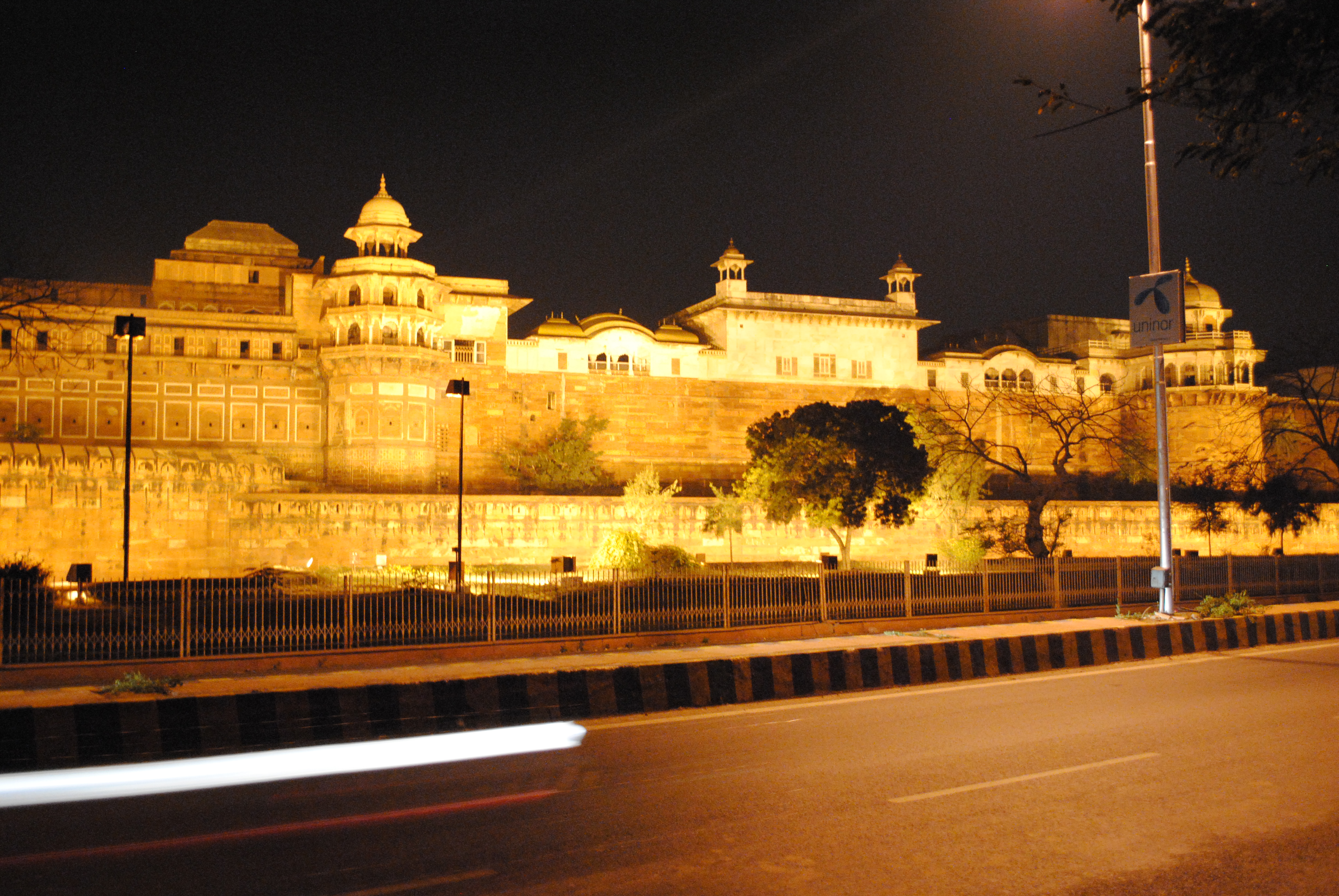Agra Fort-Agra-www.vishvabhraman.com
Agra Fort (Hindi: आगरा का किला, Urdu: آگرہ قلعہ) is a UNESCO World Heritage site located in Agra, Uttar Pradesh, India. It is about 2.5 km northwest of its more famous sister monument, the Taj Mahal. The fort can be more accurately described as a walled city.
The effect produced by lighting candles in Sheesh Mahal, Agra Fort.
The present-day structure was built by the Mughals, though a fort had stood there since at least the 11th century. Agra Fort was originally a brick fort, held by the Hindu Sikarwar Rajputs. It was mentioned for the first time in 1080 AD when a Ghaznavide force captured it. Sikandar Lodi (1488–1517) was the first Sultan of Delhi who shifted to Agra and lived in the fort. He governed the country from here and Agra assumed the importance of the second capital. He died in the fort at 1517 and his son, Ibrahim Lodi, held it for nine years until he was defeated and killed at Panipat in 1526. Several palaces, wells and a mosque were built by him in the fort during his period.
Samrat Hem Chandra Vikramaditya who won Agra in 1553 and again 1556 defeating Akbar's army
After the First Battle of Panipat in 1526, Mughals captured the fort and seized a vast treasure, including the diamond later known as the Koh-i-Noor. The victorious Babur stayed in the fort in the palace of Ibrahim and built a baoli (step well) in it. The emperor Humayun was crowned here in 1530. Humayun was defeated at Bilgram in 1540 by Sher Shah. The fort remained with Suris till 1555, when Humanyun recaptured it. The Hindu king Hem Chandra Vikramaditya, also called 'Hemu', defeated Humanyun's army, led by Iskandar Khan Uzbek, and won Agra. Hemu got a huge booty from this fort and went on to capture Delhi from the Mughals. The Mughals under Akbar defeated King Hemu finally at the Second Battle of Panipat in 1556.
Realizing the importance of its central situation, Akbar made it his capital and arrived in Agra in 1558. His historian, Abdul Fazal, recorded that this was a brick fort known as 'Badalgarh' . It was in a ruined condition and Akbar had it rebuilt with red sandstone from Barauli area in Rajasthan. Architects laid the foundation and it was built with bricks in the inner core with sandstone on external surfaces. Some 4,000 builders worked on it daily for eight years, completing it in 1573.
It was only during the reign of Akbar's grandson, Shah Jahan, that the site took on its current state. Legend has it that Shah Jahan built the beautiful Taj Mahal for his wife, Mumtaz Mahal. Unlike his grandfather, Shah Jahan tended to have buildings made from white marble, often inlaid with gold or semi-precious gems. He destroyed some of the earlier buildings inside the fort to make his own.
At the end of his life, Shah Jahan was deposed and restrained by his son, Aurangzeb, in the fort. It is rumoured that Shah Jahan died in Muasamman Burj, a tower with a marble balcony with a view of the Taj Mahal.
The fort was invaded by the Maratha Empire during the mid 18th century. Thereafter, it changed hands between the Marathas and their foes many times. After their catastrophic defeat at Third Battle of Panipat by Ahmad Shah Abdali in 1761, Marathas remained out of the region for the next decade. Finally Mahadji Shinde took the fort in 1785. It was lost by the Marathas to the British during the Second Anglo-Maratha War, in 1803.
The fort was the site of a battle during the Indian rebellion of 1857, which caused the end of the British East India Company's rule in India, and led to a century of direct rule of India by Britain.
Plan of the Red Fort, Agra from Murray's Handbooks for Travellers 1911
The 94-acre (380,000 m2) fort has a semicircular plan, its chord lies parallel to the river and its walls are seventy feet high. Double ramparts have massive circular bastions at intervals, with battlements, embrasures, machicolations and string courses. Four gates were provided on its four sides, one Khizri gate opening on to the river.
Two of the fort's gates are notable: the "Delhi Gate" and the "Lahore Gate." The Lahore Gate is also popularly also known as the "Amar Singh Gate," for Amar Singh Rathore.
-------------------------------------------------------------------------------------------------------------------------------------------------------------------------------
Get a Cheapest Fare on Bus Booking, Hotel Booking, Flight Booking & Holiday Packages only on www.vishvabhraman.com and get up to 15% discount on all Bus bookings using Coupon Code “VBSP15”
Labels: Agra Fort





0 Comments:
Post a Comment
Note: only a member of this blog may post a comment.
Subscribe to Post Comments [Atom]
<< Home